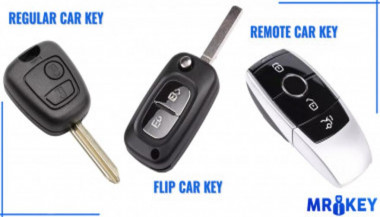Losing your motorcycle key is stressful, but the solution is almost always simpler than riders think. Whether you’re dealing with a chipped key, a worn ignition, or a code you can’t find, there are clear steps you can follow to get back on the road fast.
This guide explains how replacement motorcycle keys really work — from cutting and key codes to immobilizer compatibility — with examples from real motorcycle brands and models.
What to Do First When You Lose Your Motorcycle Key
Act quickly but stay calm. Most motorcycles can be re-keyed or cut from code without replacing expensive parts.
Check for the key code.
Look for a small alphanumeric code stamped on the ignition, seat lock, fuel cap, or original key tag. If available, a new key can be cut in minutes.
Confirm your key type.
Bikes like the BMW C600 Sport, C650GT, G310R, Suzuki Boulevard, Yamaha YZF-R1, or Honda CB/CBR/CRF may use different blanks, cuts, or chips.
Decide between a dealer or emergency locksmith.
Dealers rely on VIN lookups but may take days or weeks. A locksmith can often produce a working key on-site.
If the key was stolen, secure the bike.
A locksmith can re-key the ignition or erase the lost transponder from your system.

Cutting a New Motorcycle Key: How It Actually Works
Motorcycle keys fall into three categories:
mechanical, transponder (chipped), and keyless fobs. Replacing them works differently for each.
Mechanical Keys (most Honda, Yamaha, older Suzuki, Vespa, Piaggio)
These are simple metal keys. They can be cut even if you lost the original — locksmiths read the code or decode the lock.
Examples from your catalogue with mechanical key options:
Honda: CB Series, CBR Series, CRF, FourTrax, Goldwing, XR/XL
Yamaha: YZF-R1, YZF-R6, XJR400, FJR1300, SR400
Suzuki: Boulevard (S40/S50), Intruder (700/750/800/1400), Madura, Savage
Vespa / Aprilia / Ducati / Piaggio: ZADI key ranges C5001–C6475
These can be cut to code and shipped via replacement key delivery.
Transponder Keys (chipped)
Modern bikes often use embedded RFID chips. A new key must be:
Cut to the correct mechanical pattern
Programmed to the bike’s immobilizer or ECU
Examples with chip or immobilizer systems:
Suzuki models using 4D60 DST40 chips
Indian / KTM / Honda ZADI-system motorcycles
Newer BMW Motorrad models
A dealer or well-equipped locksmith can program transponder keys. Many quoted ECU replacements are unnecessary — a good locksmith can usually pair a new chip directly.
Keyless Fobs
Some Harley-Davidson and BMW models use proximity fobs. Losing one often immobilizes the bike entirely. Replacements require programming, and towing may be necessary.
Examples from your listings:
Harley-Davidson saddlebag and fob-linked models (LL226–LL450 range)
BMW keyless systems on touring and maxi-scooter models
Where Key Codes Are Found (and Why They Matter)
Key codes are the fastest, cheapest way to get a replacement key. They define the exact cut pattern.
Common key code locations:
Ignition barrel underside
Seat or helmet lock
Fuel cap inner plate
Owner’s manual or original key tag
ZADI-based systems (used by Vespa, Aprilia, Ducati, Piaggio, Indian, KTM) typically use numeric ranges like C5001–C6475, which Mr-Key can cut perfectly.
If no code is present, a locksmith can decode the lock manually — no need for new hardware.
Dealer vs. Emergency Locksmith: Which Is Better?
Dealers
Can order keys by VIN
Often slow and expensive
May insist on full ignition or ECU replacement
Useful for rare models or restricted fobs
Emergency Locksmiths
Faster and mobile
Cheaper than dealerships
Can cut by code, impression, or lock decoding
Can program many transponders without ECU replacement
For many riders — especially with models like Honda CB/CBR, Yamaha YZF, Suzuki Intruder, BMW G310R, Vespa/Aprilia/Piaggio — locksmiths are the most efficient choice.

Examples of Motorcycles Mr-Key Supports
BMW
C600 Sport
C650GT
G310R
Honda
CB Series
CBR Series
CRF Series
FourTrax
Goldwing
XR / XL
Honda ATV (A00–A99 / B00–B99 codes, 1983–2022)
Yamaha
YZF-R1
YZF-R6
XJR400
FJR1300
SR400
Suzuki
Boulevard S40 / S50
Intruder 700 / 750 / 800 / 1400
Madura
Savage
4D60 DST40 transponder models
Harley-Davidson
Saddle Bag LL226–LL450
Keyless fob models
Vespa / Aprilia / Ducati / Piaggio
ZADI key codes C5001–C6475
Multiple standard ignition and seat locks
KTM / Indian
Supported in ZADI Indian/Vespa/KTM/Honda product line
How to Avoid Losing Your Key Again
Make a spare immediately and store it safely.
Add a bright keychain or Bluetooth tracker.
Know your emergency start PIN (for keyless bikes).
Keep your key code and VIN stored separately from the bike.
The AA advises riders to secure spares and document key numbers.
FAQ
Can a locksmith make a motorcycle key without the original?
Yes. Locksmiths can cut by code or decode your ignition/lock manually.
Can I get a new key using my motorcycle’s VIN?
Dealers can often retrieve the factory key code from the VIN, though delays are common.
What if my lost key had a chip?
You’ll need both cutting and immobilizer programming. Locksmiths handle this for most brands.
Do I need to replace the ignition?
Rarely. Only if the key was stolen and security is compromised — not because the key is lost.
Need a Replacement Motorcycle Key Fast?
If you need a mechanical, transponder, or ZADI-system motorcycle key — or a code-cut replacement delivered to your home — we specialize in fast, professional solutions.
Visit our shop at mr-key.com to order a replacement key or request an emergency locksmith.




_1750675930.jpg)
